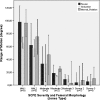Femoral morphology due to impingement influences the range of motion in slipped capital femoral epiphysis
- PMID: 18941860
- PMCID: PMC2635459
- DOI: 10.1007/s11999-008-0477-z
Femoral morphology due to impingement influences the range of motion in slipped capital femoral epiphysis
Abstract
Femoroacetabular impingement due to metaphyseal prominence is associated with the slippage in patients with slipped capital femoral epiphysis (SCFE), but it is unclear whether the changes in femoral metaphysis morphology are associated with range of motion (ROM) changes or type of impingement. We asked whether the femoral head-neck junction morphology influences ROM analysis and type of impingement in addition to the slip angle and the acetabular version. We analyzed in 31 patients with SCFE the relationship between the proximal femoral morphology and limitation in ROM due to impingement based on simulated ROM of preoperative CT data. The ROM was analyzed in relation to degree of slippage, femoral metaphysis morphology, acetabular version, and pathomechanical terms of "impaction" and "inclusion." The ROM in the affected hips was comparable to that in the unaffected hips for mild slippage and decreased for slippage of more than 30 degrees. The limitation correlated with changes in the metaphysic morphology and changed acetabular version. Decreased head-neck offset in hips with slip angles between 30 degrees and 50 degrees had restricted ROM to nearly the same degree as in severe SCFE. Therefore, in addition to the slip angle, the femoral metaphysis morphology should be used as criteria for reconstructive surgery.
Figures





References
-
- {'text': '', 'ref_index': 1, 'ids': [{'type': 'PubMed', 'value': '9225384', 'is_inner': True, 'url': 'https://pubmed.ncbi.nlm.nih.gov/9225384/'}]}
- Boles CA, el-Khoury GY. Slipped capital femoral epiphysis. Radiographics. 1997;17:809–823. - PubMed
-
- {'text': '', 'ref_index': 1, 'ids': [{'type': 'PubMed', 'value': '7451529', 'is_inner': True, 'url': 'https://pubmed.ncbi.nlm.nih.gov/7451529/'}]}
- Boyer DW, Mickelson MR, Ponseti IV. Slipped capital femoral epiphysis: long-term follow-up study of one hundred and twenty-one patients. J Bone Joint Surg Am. 1981;63:85–95. - PubMed
-
- {'text': '', 'ref_index': 1, 'ids': [{'type': 'PubMed', 'value': '2045391', 'is_inner': True, 'url': 'https://pubmed.ncbi.nlm.nih.gov/2045391/'}]}
- Carney BT, Weinstein SL, Noble J. Long-term follow-up of slipped capital femoral epiphysis. J Bone Joint Surg Am. 1991;73:667–674. - PubMed
-
- None
- Debrunner HU. Orthopädisches Diagnostikum. Stuttgart, Germany: Georg Thieme Verlag; 1973.
-
- {'text': '', 'ref_index': 1, 'ids': [{'type': 'PubMed', 'value': '1517417', 'is_inner': True, 'url': 'https://pubmed.ncbi.nlm.nih.gov/1517417/'}]}
- Futami T, Kasahara Y, Suzuki S, Seto Y, Ushikubo S. Arthroscopy for slipped capital femoral epiphysis. J Pediatr Orthop. 1992;12:592–597. - PubMed

